brycercampbell
Active member
Hey, I've been using my Garmin inReach Mini for over 8 months now and wanted to share my thoughts. I purchased the unit, and pay for it monthly. The article is pretty upbeat with not much negative to say, because I've genuinely had zero bad experiences (except for an Iridium outage a few days ago?). I'm writing this from the point of view of an average consumer who did a few hours of research and comparison before purchasing, with a basic understanding of GPS and satellite networks. Enjoy.
--
Do you answer calls from unknown numbers? I certainly don’t. Neither did that hiker who got lost in Lake County, CO a few days ago. Authorities tried to call him, he received the calls, yet he didn’t answer them because he didn’t know who was calling!
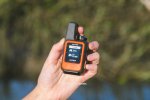
You never want to be lost in the woods relying on cell service. With the amount of readily available, and relatively inexpensive, satellite communicators on the market, you don’t have to. More importantly, when you lose cell service, you need to have a backup.
Satellite communicators come in different forms, though some of the more popular options are the Garmin InReach line and the Somewear Labs Global Hotspot. Both run on the Iridium satellite network, and when I was looking at purchasing a satellite communicator, it came down to the inReach Mini and the Somewear Hotspot, and I’m sure others are in the same situation.
I’ve been using the inReach Mini for almost a year now. Firstly, why did I choose the Mini over the Somewear Hotspot?
Although the Hotspot is less expensive, it is dependent on a separate device — your phone. It has no independent functionality. In a scenario where I am using satellite communication to reach someone, I want to have redundancy. The Garmin inReach Mini can be used as a hotspot — through the Earthmate app — or as a standalone communicator. That made the increased price worth it for me. If you are comfortable relying exclusively on your phone, then perhaps the Somewear Labs Hotspot is the way to go for you.
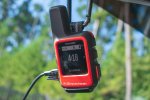
With that in mind, it’s fitting that I discuss the Mini’s durability first. Frankly, the device is pretty much invincible. I either have it clipped to a piece of my trucks dashboard, banging around as I cruise over terrible washboard roads, or on the front of my hiking pack, where I have taken a few tumbles. The device is practically unscathed except for a few scratches on the rubbery material that it’s built out of. It is IPX7 waterproof rated, which means it can withstand 30 minutes under 3ft of water. That also means it’s pretty well sealed against dust. All the ports on the device have flaps that plug them tightly.
My only concern, longterm, is battery degradation. It happens to all electronics over time, though in the past year that I’ve had the device, I’ve had no problems. Unfortunately, Garmin will not replace the battery in the InReach, nor is it user accessible. A questionable choice on such a durable and (hopefully) long lasting device.
On the topic of the battery, so far the battery life has been impressive — though a bit less than advertised. I have my Mini set up to send a tracking point every 10 minutes, Garmin claims with that setup it can last 90 hours. I’ve found it to be closer to 72 hours. Simply change that 10 minute tracking time to 30 minutes, and the battery life expands exponentially.

The inReach Mini can also log your location locally for later upload every 1, 2, or 5 minutes. This is separate from the tracking points that are uploaded for friends or family to view. They can later be uploaded to MapShare through the InReach Sync program — though I rarely use this feature.
As I’ve mentioned before, there is a companion app for the Mini. It’s called Earthmate, and technically speaking, it’s impressive. I’ve had no bugs or errors or crashes, it loads quick, and has a pretty simply UI. If using the app, the inReach acts more as a hotspot rather than a satellite communicator itself. I really enjoy having the option to use my phone in partnership with the device or use the device on its own. It’s far easier to send messages through the app than letter-by-letter with the Mini, and the weather forecast (see below) is much easier to read.
The inReach Mini can provide you a 3 day weather forecast through the satellite connection at the cost of 1 text message for a basic weather forecast, or $1.00 for a “premium” forecast. I’ve found the basic forecast to work adequately.

But perhaps the biggest reason you’re considering an inReach, and ultimately the reason why I bought mine, is because of the SOS feature. In the event of something catastrophic, you lift the cap and press the SOS button. You’ll then be connected to the Garmin-powered International Emergency Response Coordination Center. A fancy name, but in practical terms, a dispatch center that contacts the appropriate authorities and can communicate with you both ways. This is NOT available without a subscription.
As for pricing, the unit itself cost me $350. That seems to be what it’s going for now, but with Black Friday and Christmas, you might be able to snag it for less.
There are 3 different subscription plans: Safety, Recreation, and Expedition.
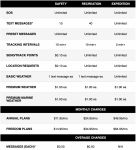
Without a subscription, the unit is basically dead weight. Make sure you factor in the cost of the subscription when deciding whether to purchase the inReach Mini or competing devices.
Personally, I use the Recreation plan on a month-to-month basis. When I am not traveling, I pause the subscription. For the Recreation plan, you have to use the Mini over 8 months to save money vs the Annual subscription.
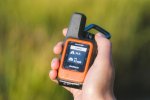
In summary, whenever I go hiking, camping, or go anywhere for an extended period without cell service, I take my inReach Mini. Frankly, the only downside to the unit is the subscription cost. In my mind, there are levels of importance in your safety equipment. There are mandatory things, such as a knife, shovel, and a first aid kit. Then there is the second layer, things that you can go without but will make your life much easier or safer. I think the inReach, and all satellite communicators, fall into that second category. If you don’t have a way to communicate outside of cell signal, it’s not worth cancelling your next camping trip. But it is worth thinking about sooner rather than later.
---
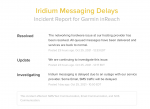
Screenshot from @Bill Ruttan
Since writing this article a few days ago, I saw on another thread that there was a messaging outage on Oct. 25 due to the Iridium network. I've never seen this happen before, and hopefully it doesn't happen again. But definitely worth mentioning.
Thanks for reading.
--
Do you answer calls from unknown numbers? I certainly don’t. Neither did that hiker who got lost in Lake County, CO a few days ago. Authorities tried to call him, he received the calls, yet he didn’t answer them because he didn’t know who was calling!

You never want to be lost in the woods relying on cell service. With the amount of readily available, and relatively inexpensive, satellite communicators on the market, you don’t have to. More importantly, when you lose cell service, you need to have a backup.
Satellite communicators come in different forms, though some of the more popular options are the Garmin InReach line and the Somewear Labs Global Hotspot. Both run on the Iridium satellite network, and when I was looking at purchasing a satellite communicator, it came down to the inReach Mini and the Somewear Hotspot, and I’m sure others are in the same situation.
I’ve been using the inReach Mini for almost a year now. Firstly, why did I choose the Mini over the Somewear Hotspot?
Although the Hotspot is less expensive, it is dependent on a separate device — your phone. It has no independent functionality. In a scenario where I am using satellite communication to reach someone, I want to have redundancy. The Garmin inReach Mini can be used as a hotspot — through the Earthmate app — or as a standalone communicator. That made the increased price worth it for me. If you are comfortable relying exclusively on your phone, then perhaps the Somewear Labs Hotspot is the way to go for you.

With that in mind, it’s fitting that I discuss the Mini’s durability first. Frankly, the device is pretty much invincible. I either have it clipped to a piece of my trucks dashboard, banging around as I cruise over terrible washboard roads, or on the front of my hiking pack, where I have taken a few tumbles. The device is practically unscathed except for a few scratches on the rubbery material that it’s built out of. It is IPX7 waterproof rated, which means it can withstand 30 minutes under 3ft of water. That also means it’s pretty well sealed against dust. All the ports on the device have flaps that plug them tightly.
My only concern, longterm, is battery degradation. It happens to all electronics over time, though in the past year that I’ve had the device, I’ve had no problems. Unfortunately, Garmin will not replace the battery in the InReach, nor is it user accessible. A questionable choice on such a durable and (hopefully) long lasting device.
On the topic of the battery, so far the battery life has been impressive — though a bit less than advertised. I have my Mini set up to send a tracking point every 10 minutes, Garmin claims with that setup it can last 90 hours. I’ve found it to be closer to 72 hours. Simply change that 10 minute tracking time to 30 minutes, and the battery life expands exponentially.

The inReach Mini can also log your location locally for later upload every 1, 2, or 5 minutes. This is separate from the tracking points that are uploaded for friends or family to view. They can later be uploaded to MapShare through the InReach Sync program — though I rarely use this feature.
As I’ve mentioned before, there is a companion app for the Mini. It’s called Earthmate, and technically speaking, it’s impressive. I’ve had no bugs or errors or crashes, it loads quick, and has a pretty simply UI. If using the app, the inReach acts more as a hotspot rather than a satellite communicator itself. I really enjoy having the option to use my phone in partnership with the device or use the device on its own. It’s far easier to send messages through the app than letter-by-letter with the Mini, and the weather forecast (see below) is much easier to read.
The inReach Mini can provide you a 3 day weather forecast through the satellite connection at the cost of 1 text message for a basic weather forecast, or $1.00 for a “premium” forecast. I’ve found the basic forecast to work adequately.

But perhaps the biggest reason you’re considering an inReach, and ultimately the reason why I bought mine, is because of the SOS feature. In the event of something catastrophic, you lift the cap and press the SOS button. You’ll then be connected to the Garmin-powered International Emergency Response Coordination Center. A fancy name, but in practical terms, a dispatch center that contacts the appropriate authorities and can communicate with you both ways. This is NOT available without a subscription.
As for pricing, the unit itself cost me $350. That seems to be what it’s going for now, but with Black Friday and Christmas, you might be able to snag it for less.
There are 3 different subscription plans: Safety, Recreation, and Expedition.

Without a subscription, the unit is basically dead weight. Make sure you factor in the cost of the subscription when deciding whether to purchase the inReach Mini or competing devices.
Personally, I use the Recreation plan on a month-to-month basis. When I am not traveling, I pause the subscription. For the Recreation plan, you have to use the Mini over 8 months to save money vs the Annual subscription.

In summary, whenever I go hiking, camping, or go anywhere for an extended period without cell service, I take my inReach Mini. Frankly, the only downside to the unit is the subscription cost. In my mind, there are levels of importance in your safety equipment. There are mandatory things, such as a knife, shovel, and a first aid kit. Then there is the second layer, things that you can go without but will make your life much easier or safer. I think the inReach, and all satellite communicators, fall into that second category. If you don’t have a way to communicate outside of cell signal, it’s not worth cancelling your next camping trip. But it is worth thinking about sooner rather than later.
---

Screenshot from @Bill Ruttan
Since writing this article a few days ago, I saw on another thread that there was a messaging outage on Oct. 25 due to the Iridium network. I've never seen this happen before, and hopefully it doesn't happen again. But definitely worth mentioning.
Thanks for reading.
